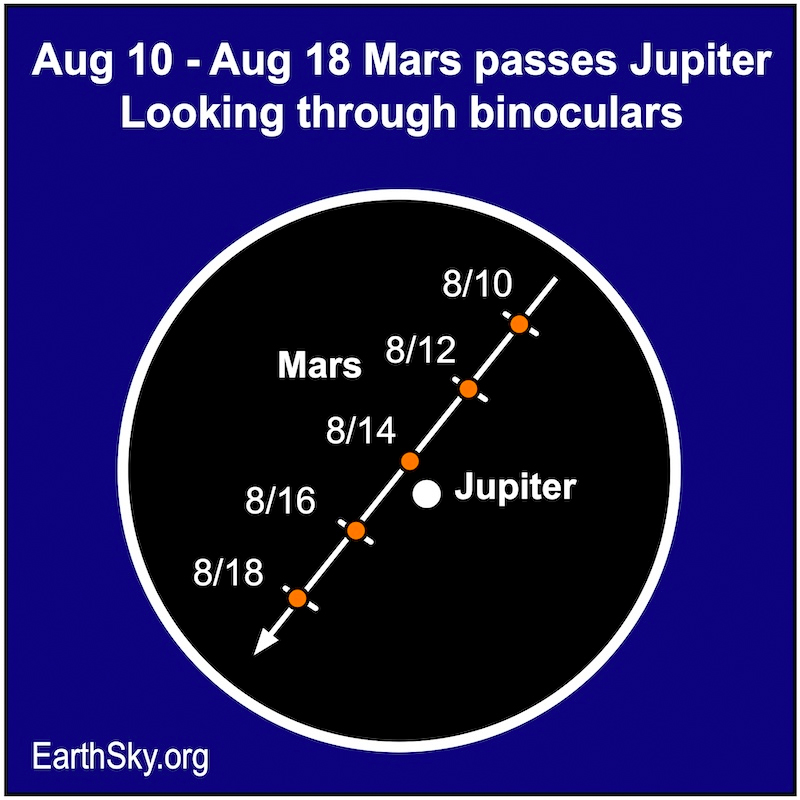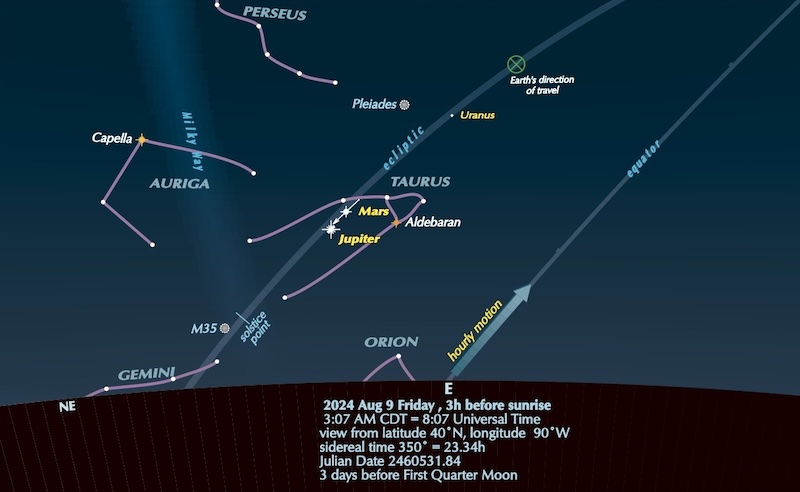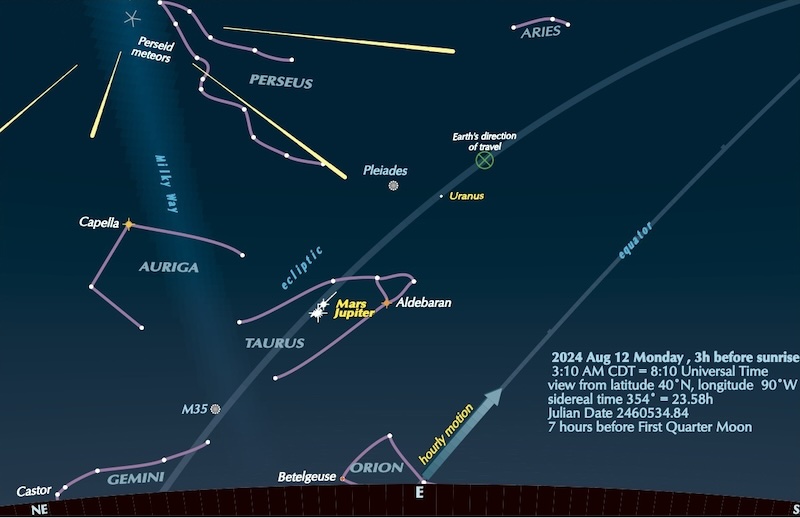
Jupiter and Mars to pair up August 14
Bright Jupiter and red Mars have been near each other in the east before sunup all month. And – if you watch in the coming week – you’ll get to see Jupiter sideswipe Mars in a conjunction. They’ll be closest on August 14. Afterwards, Mars will be creeping higher in the predawn sky, brightening slowly. Jupiter will ascend faster, pulling rapidly away from Mars, steadily moving toward the evening sky and its early December, 2024, opposition.
Jupiter and Mars are in front of the constellation boundary into Taurus the Bull. There are many splendid things to see in Taurus. This conjunction will be fun!
The two are not far from the misty Pleiades star cluster.
And they’re near bright Aldebaran – Eye of the Bull in Taurus – and a rival in brightness and color to Mars.
Read: Why is Mars sometimes bright and sometimes faint?
Here’s a 1-minute video preview of Jupiter and Mars conjunction around August 14.
The big event: Jupiter and Mars conjunction
The closest pairing of this planetary duo will come on the morning of August 14. That’s when bright gas giant Jupiter will get a visit from rocky red Mars on our sky’s dome. Then, the little planet will appear less than the width of a full moon from Jupiter. They’ll look close on our sky’s dome. In reality, the two will remain more than 300 million miles (500 million km) apart, even though they are next-door neighbors in our solar system.
Using just the unaided eye, the bright white light of Jupiter will contrast nicely with the dimmer and distinctly redder shine of Mars. In binoculars, Jupiter’s moons will enhance your enjoyment of the view. And this conjunction will be a great event for telescope owners and astrophotographers. You’ll be able to capture both planets in one view and thoroughly examine these remarkably different worlds. If you catch a great pic, please submit it to EarthSky’s community page!

Charts from UK astronomer Guy Ottewell
The following charts are from beloved U.K. astronomer Guy Ottewell. He’s perhaps the world’s greatest living night sky illustrator! You’ll find more charts like these for 2024 in his Astronomical Calendar.


Heliocentric solar system view of the planets in August 2024
Here’s more from Guy Ottewell … a heliocentric view of the solar system from above for August when Jupiter and Mars will appear close together in the morning sky. Guy Ottewell explains his heliocentric charts here .

Bottom line: The Jupiter and Mars conjunction in the morning sky is this week! They’ll be closest on August 14. Look east!
The post Don’t miss! Jupiter and Mars conjunction this week first appeared on EarthSky.
from EarthSky https://ift.tt/sHeSvwO

Jupiter and Mars to pair up August 14
Bright Jupiter and red Mars have been near each other in the east before sunup all month. And – if you watch in the coming week – you’ll get to see Jupiter sideswipe Mars in a conjunction. They’ll be closest on August 14. Afterwards, Mars will be creeping higher in the predawn sky, brightening slowly. Jupiter will ascend faster, pulling rapidly away from Mars, steadily moving toward the evening sky and its early December, 2024, opposition.
Jupiter and Mars are in front of the constellation boundary into Taurus the Bull. There are many splendid things to see in Taurus. This conjunction will be fun!
The two are not far from the misty Pleiades star cluster.
And they’re near bright Aldebaran – Eye of the Bull in Taurus – and a rival in brightness and color to Mars.
Read: Why is Mars sometimes bright and sometimes faint?
Here’s a 1-minute video preview of Jupiter and Mars conjunction around August 14.
The big event: Jupiter and Mars conjunction
The closest pairing of this planetary duo will come on the morning of August 14. That’s when bright gas giant Jupiter will get a visit from rocky red Mars on our sky’s dome. Then, the little planet will appear less than the width of a full moon from Jupiter. They’ll look close on our sky’s dome. In reality, the two will remain more than 300 million miles (500 million km) apart, even though they are next-door neighbors in our solar system.
Using just the unaided eye, the bright white light of Jupiter will contrast nicely with the dimmer and distinctly redder shine of Mars. In binoculars, Jupiter’s moons will enhance your enjoyment of the view. And this conjunction will be a great event for telescope owners and astrophotographers. You’ll be able to capture both planets in one view and thoroughly examine these remarkably different worlds. If you catch a great pic, please submit it to EarthSky’s community page!

Charts from UK astronomer Guy Ottewell
The following charts are from beloved U.K. astronomer Guy Ottewell. He’s perhaps the world’s greatest living night sky illustrator! You’ll find more charts like these for 2024 in his Astronomical Calendar.


Heliocentric solar system view of the planets in August 2024
Here’s more from Guy Ottewell … a heliocentric view of the solar system from above for August when Jupiter and Mars will appear close together in the morning sky. Guy Ottewell explains his heliocentric charts here .

Bottom line: The Jupiter and Mars conjunction in the morning sky is this week! They’ll be closest on August 14. Look east!
The post Don’t miss! Jupiter and Mars conjunction this week first appeared on EarthSky.
from EarthSky https://ift.tt/sHeSvwO

Aucun commentaire:
Enregistrer un commentaire